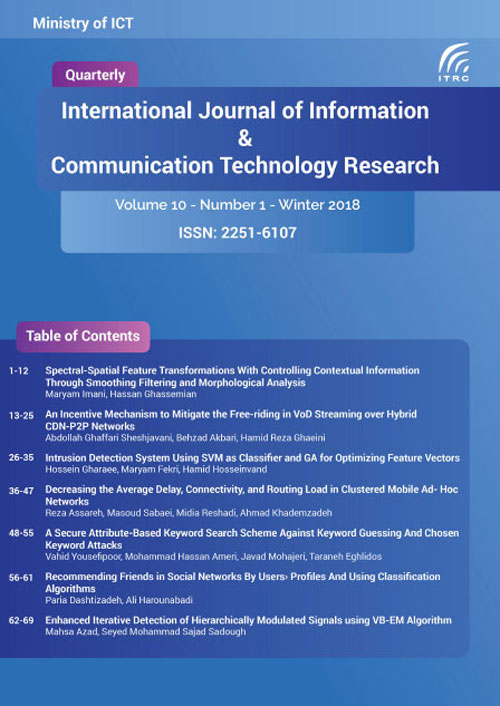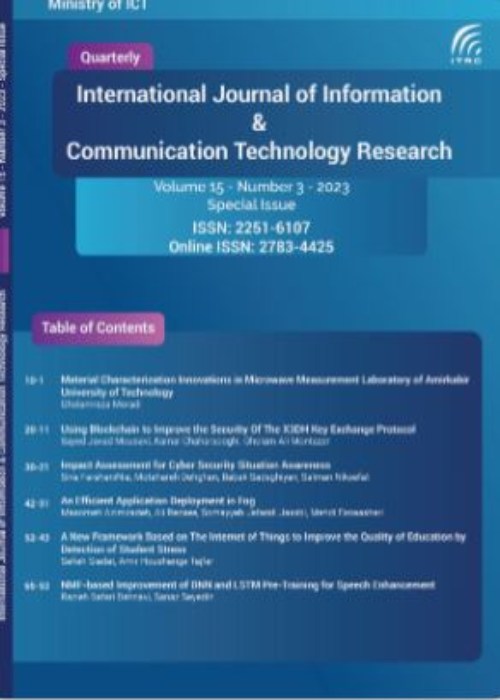فهرست مطالب

International Journal Information and Communication Technology Research
Volume:10 Issue: 1, Winter 2018
- تاریخ انتشار: 1397/11/03
- تعداد عناوین: 7
-
-
Pages 1-12A fusion method for spectral-spatial classification of hyperspectral images is proposed in this paper. In the proposed framework, at first, the dimension of hyperspectral image is reduced by several state-of-the-art spectral feature extraction methods, i.e., Binary Coding Based Feature Extraction (BCFE), Clustering Based Feature Extraction (CBFE), Feature Extraction Based on Ridge Regression (FERR), Feature Extraction Using Attraction Points (FEUAP), Feature Extraction using Weighted Training samples (FEWT), and Feature Space Discriminant Analysis (FSDA). Then, the spatial features are calculated from the spectral features extracted from each spectral feature extraction method individually using the proposed smoothing filters and morphological operators. Finally, majority voting decision rule is used to obtain the final classification map. The proposed framework, in addition to removing the useless spatial information such as noise and distortions, adds useful spatial information such as shape and size of objects presented in scene image. The use of complement information obtained from six spectral feature extraction methods with different ideas for class discrimination, significantly improves the classification results. The proposed framework provides in average 6.64%, 7.07%, 8.23%, 7.52% and 20.52% improvement in classification results of three real hyperspectral images compared to generalized composite kernel (GCK), multiple feature learning (MFL), weighted joint collaborative representation (WJCR), original hyperspectral bands stacked on extended morphological profile (HS+EMP) and original hyperspectral bands (HS), respectively in terms of overall accuracy.Keywords: spectral-spatial features, feature transformation, classification, majority voting, hyperspectral data
-
Pages 13-25Peer organization is one of the most challenging issues in peer-to-peer (P2P) video streaming systems. Free-riding reduces the overall performance of these systems. The peers placed closer to the video source will have a higher quality of service. Therefore, we can mitigate the free-riding effect and encourage peers to increase uploading participation by putting peers with more upload bandwidth closer to the video sources and setting free riders far from these video sources. In this paper, we propose a distributed incentive mechanism, which extensively enhances mesh-based P2P video-on-demand streaming systems. In our proposed mechanism, peers will organize an overlay based on their playback point and contributed upload bandwidth. This mechanism applies to both P2P, and hybrid CDN-P2P approaches. The obtained results demonstrate the efficiency of our proposal in term of the quality of service, robustness in dynamic environments and resiliency against free riding.Keywords: video-on-demand, peer-to-peer, improvement Mechanism, incentive mechanism, Video streaming
-
Pages 26-35Nowadays, IDS is an essential technology for defense in depth. Researchers have interested on IDS using data mining and artificial intelligence (AI) techniques as an artful. IDSs can monitor system behavior and network traffic until detect intrusive action. One of the IDS models is anomaly based IDS which trained to distinguish between normal and abnormal traffic. This paper has proposed an anomaly based IDS using GA for optimizing feature vectors and SVM as a classifier. SVM has used as a supervised learning machine that analyses data and recognize patterns, used for classification and regression analysis. After optimization best features for SVM, IDS can detect abnormal traffic more accurate. There is an innovation in fitness function which is formed from TPR, FPR and the number of selected features. The new fitness function reduced the dimension of the data, increased true positive detection and simultaneously decreased false positive detection. In addition, the computation time for training will also have a remarkable reduction. This study proposes a method which can achieve more stable features in comparison with other techniques. The proposed model has been evaluated test with KDD CUP 99 and UNSW-NB15 datasets. Numeric Results and comparison to other models have been presented.Keywords: Intrusion Detection System, Genetic, SVM, Feature Selection
-
Pages 36-47Clustering is an efficient method for increasing scalability in mobile ad hoc networks. In this method, several nodes called clusterheads are responsible for serving the nodes in their cluster. Choosing the optimal number of clusterheads can improve the quality-of-service metrics such as delay in clustered networks. There have been several studies to model the delay in mobile ad hoc networks with flat structure, but assessing the delay in clustered networks is still open research topic. In this paper, first we model the average hop count in clustered mobile ad hoc networks, and then, analytically, we show that an increased number of clusterheads increases the probability of new routes with lower hop counts and consequently, reduces delay in each connection. The effect of the number of clusterheads on average delay and two other metrics; connectivity and routing load is analyzed for two types of clustering methods with and without gateways.Keywords: Average Delay, Connectivity, Clusterheads, Routing Load, Hop Count
-
Pages 48-55To provide the privacy of the users who receive some computing services from the cloud, the users must encrypt their documents before outsourcing them to the cloud. Computation on outsourced encrypted data in the cloud rises some complexity to the system especially in the case when an entity would like to find some documents related to a special keyword. Searchable encryption is a tool for data owners to encrypt their data in a searchable manner. Generally, there exist two kinds of searchable encryption, namely symmetric (secret key) and asymmetric (public key) ones. Most of the public key searchable encryption schemes are vulnerable to the keyword guessing attack (KGA). In this paper, we propose an attribute-based keyword search scheme which is proved to be secure against KGA. Also, we formally prove that the proposed scheme is secure against another attack, namely the chosen keyword attack (CKA) in the random oracle model.Keywords: Attribute-based keyword search, searchable encryption, keyword guessing attack, chosen keyword attack, cloudsecurity
-
Pages 56-61Nowadays, social networks are becoming more popular, so the number of their users and their information is growing accordingly. Therefore, we need a recommender system that uses all kinds of available information to create highly accurate recommendations. Regarding the general structure of these recommender systems, one criterion is first chosen to calculate the similarity between users and then people who are assumed to have great similarity are proposed to each other as friend. These similar criteria can calculate users’ similarity with regard to topological structure and some properties of graph vertices. In this paper, the properties that are required for clustering are extracted from users’ profile. Finally, by combining the similarity criteria of mean measure of divergence (MMD), cosine, and Katz, different aspects of the problem including graph topology, frequency of user interaction with each other, and normalization of the same scoring method are considered.Keywords: social network, friend recommendation, graph clustering, users’ profiles, link prediction
-
Pages 62-69In Hierarchical Modulation (HM), the binary data is partitioned into a “high-priority” (HP) and a “low-priority” (LP) bit stream that are separately and independently encoded before being mapped on non-uniformly spaced constellation points. Indeed, HM is a multi-level modulation scheme, proposed for enabling unequal error protection. The HP and LP streams vary in their susceptibility to noise. The basic HP signal is more robust, in other words, heavily protected against noise and interference, whereas the LP stream has much less robustness. In this paper, we propose an improved iterative receiver based on variational Bayesian expectation-maximization (VB-EM) scheme for semi-blind joint channel estimation and data detection based on bit-interleaved coded modulation (BICM), with the aim of improving the bit error rate (BER) of the noisy LP stream. Moreover, the proposed receiver allows us to reduce the pilot symbol overhead compared to the classical HM receivers based on pilot-assisted channel estimation.Keywords: Hierarchical modulation, BICM, Iterative Receiver, Variational Bayesian Expectation-Maximization (VB-EM) algorithm


